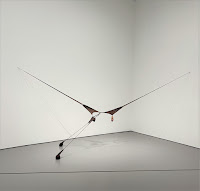A former private mansion rue de Grenelle in Paris shelters the permanent collection of the Musée Maillol, primarily dedicated to the sculptor. Usually quiet, the venue with its grand staircase and dark rooms, is taken over by a crowd spilling in the street, attracted by the travelling exhibition Hyperréalisme: Ceci n'est pas un corps ("Hyperrealism: this is not a body") well-advertised on tourists' websites. Hyperrealism includes a whole gamut of realistic paintings and sculptures with a twist, hence the prefix, and emerges from photorealism, an American art movement born sometimes in the 1960's as a reaction to the post-WWII abstract movement. Confused by the shapes, colors, and meanings of nonrepresentational works, frustrated visitors come by, eager to look at art they can relate to. The exhibition features thirty six works from thirty artists and spans almost forty years. In addition, a special display highlights four pieces spread among Maillol's permanent collection on the top floor .
What I thought was a distraught visitor leaning against the wall turned out to be my first encounter with the show: a life-like sculpture with long blond hair, wearing jeans and t-shirt like everyday teenager, Caroline, 2014, from Daniel Firman. The cow-boy and two tired laborers from Duane Hanson and Ethyl, 2003, from Tom Kuebler fit perfectly the first theme "Human Replicas". In the same realistic vein, cliché with their props: hats, boots, buckets or a lasso for the cow-boy, they look cartoonish and fail to provoke an emotional connection. In contrast, two sculptures in polychrome bronze, John Deandrea's American Icon - Kent State, 2015 and Dying Gaul, 2010, are unsettling. In the dark room, their bodies glowing under the spotlights, the distressed naked humans are represented in their most intimate details, pubic hair included, and their poses speak of a tragic destiny, one of violent death. Moving on, the moody sculpture from George Segal Blue Girl on Park Bench, 1980, expresses the sadness of loneliness through the melancholy of the color blue. Farther, a nude also from Segal, appears abandoned, drifting on a couch, white like a ghost. Representing himself with a (tortured) tree trunk from the waist down or surrounded by birds, Fabien Merelle's self-portraits allude to his deep connection with nature. More nudes fill this section dedicated to monochrome works with among them a very classical portrait in marble from Fabio Viale. "Parts of the Body" is taken over by a central piece from Peter Land, an adjustable body, another self-portrait asleep this time, snaking its way at the center of the room. Valter Adam Casotto cuts his body in pieces. Enlarged lips, elbow, palm, ..., with magnified creases and lines are covered with innocent drawings from his childhood, a not so subtle allusion to aging. Andy Warhol's bust by Kazu Hiro appears very official with his grey hair well parted, closely shaved face, looking down at the viewer, without a smile, chin firmly set on two fingers in a judgmental pose, ready to take his place at Madame Tussauds. An iconic sculpture from Carole Feuerman and the famous Ave Maria, 2007, from Maurizio Cattelan, get lost in the display. "Playing with Size" and "Deformed Realities" assemble almost half of the group show's artists who represent diverse countries and continents: Australia, Serbia, Italy, Republic of North Macedonia, Belgium, South Africa, Sierra Leone, United States, a testimony to the international reach of hyperrealism.
One can find works from Ron Mueck or Berlinde de Bruyckere next to those of less known artists, showcasing the diversity of backgrounds and practices. Following the rich display, "Shifting Boundaries", the exhibition's last chapter provides a glimpse into the future of hyperrealism, and sculpture in general, when the boundaries between fiction and reality are blurred and technology becomes the art as illustrated by the talkative animated piece Jonathan, 2009, from the duo Glaser/Kunz. At the end, the irresistible selfie takes over the show with the visitors lining up to become the subject of Erwin Wurm's piece Idiot II, 2003, eager to expose themselves to the anonymous crowd of social media.
Repulsion, compassion, indifference, the viewers go through a whole gamut of emotions mixed with curiosity and voyeurism. Many resist the temptation to touch the more haptic pieces of art... are they real? Spread in the rooms, loop videos of artists' interviews in which they reveal their techniques take away some of the magic. More or less relevant quotes are also available on the walls. However the bodies frozen for eternity appear objectified rather than transcended and this impression becomes more acute when they are spread among Maillol's sculptures. The short conclusion to the show leaves us pondering about the future of hyperrealism, stretched to the absurd.
Upcoming: three special showings for naturists allowed to go through the exhibition totally naked!









